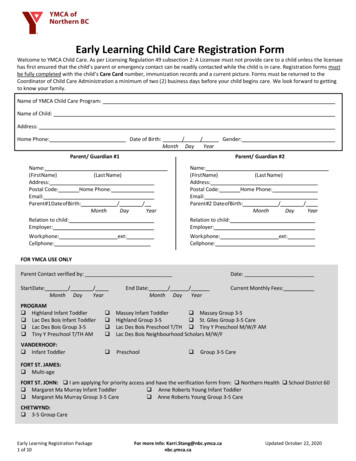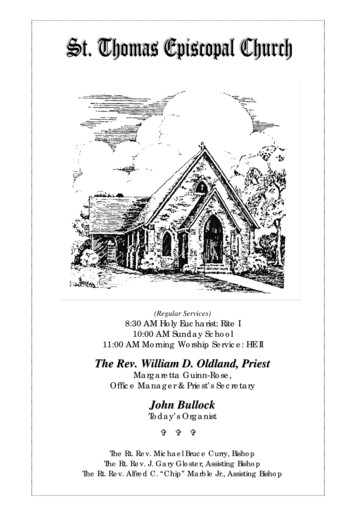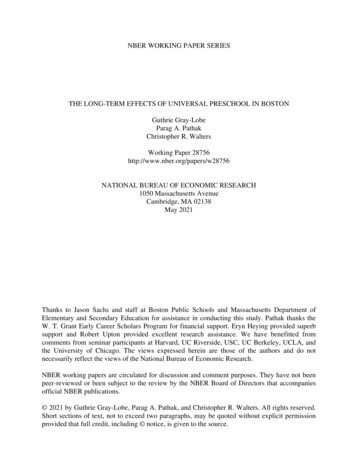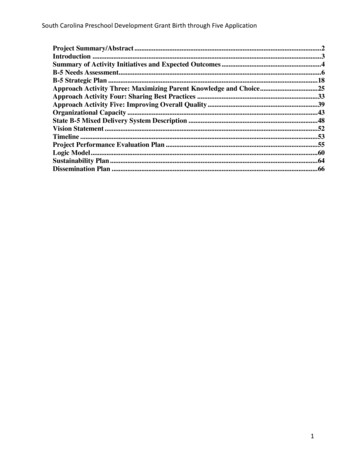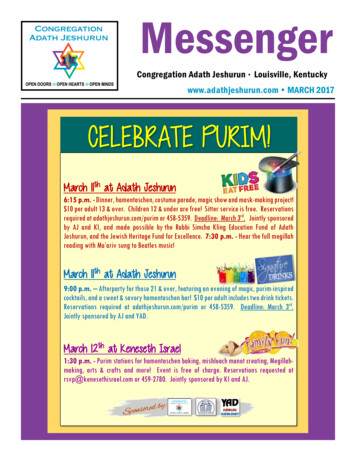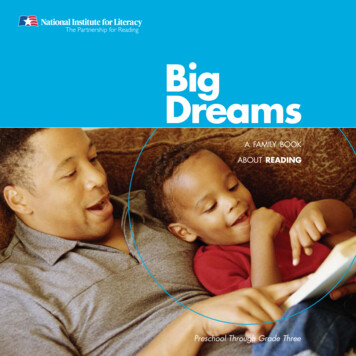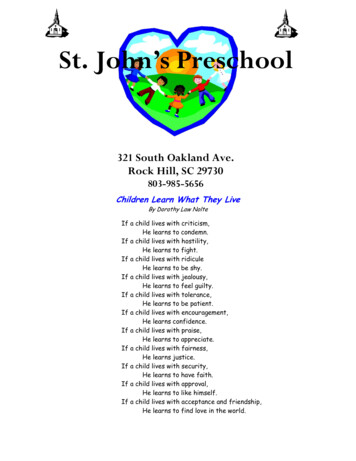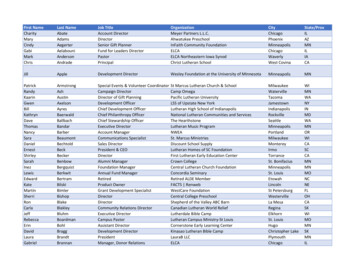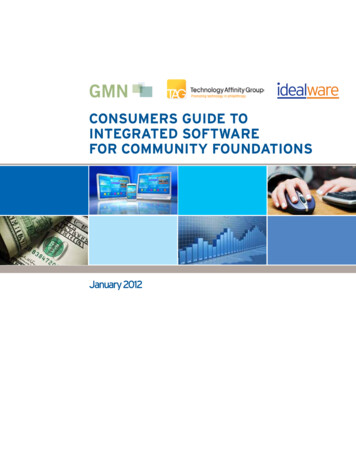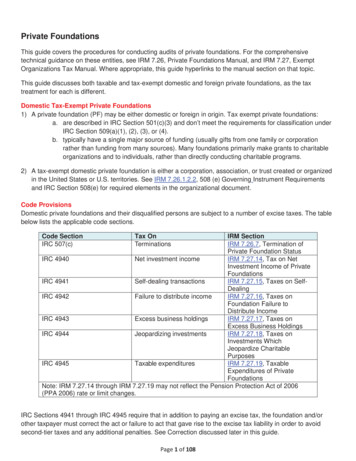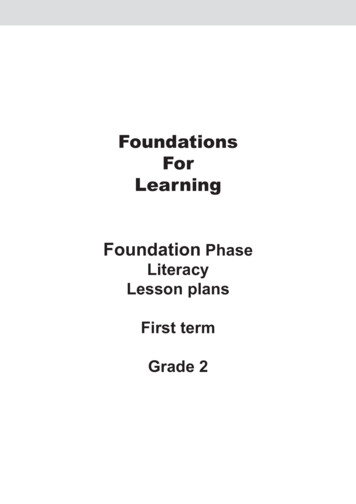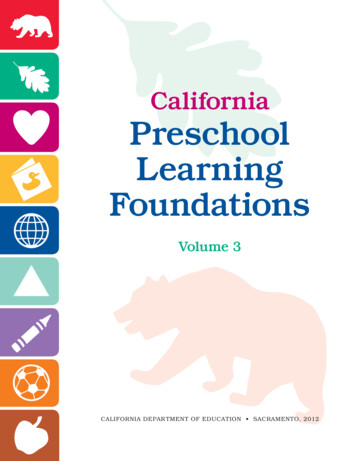
Transcription
CaliforniaPreschoolLearningFoundationsVolume 3CALIFORNIA DEPAR TMENT OF EDUCATION SACRAMENTO, 2012
CaliforniaPreschoolLearningFoundationsVolume 3History–Social ScienceScience
Publishing InformationThe California Preschool Learning Foundations (Volume 3) wasdeveloped by the Child Development Division, California Departmentof Education. This publication was edited by Faye Ong, working incooperation with Laura Bridges, Consultant, Child DevelopmentDivision. It was designed and prepared for printing by the staffof CDE Press, with the cover and interior design created byCheryl McDonald. It was published by the Department of Education,1430 N Street, Sacramento, CA 95814-5901. It was distributedunder the provisions of the Library Distribution Act and GovernmentCode Section 11096. 2012 by the California Department of EducationAll rights reservedISBN 978-8011-1727-5Ordering InformationCopies of this publication are available for sale from the California Department of Education. For prices and ordering information, pleasevisit the Department Web site at http://www.cde.ca.gov/re/pn/rc/ or callthe CDE Press Sales Office at 1-800-995-4099.NoticeThe guidance in the California Preschool Learning Foundations(Volume 3) is not binding on local educational agencies or otherentities. Except for the statutes, regulations, and court decisions thatare referenced herein, the documents is exemplary, and compliancewith it is not mandatory. (See Education Code Section 33308.5.)
vContentsA Message from the State Superintendentof Public ions inHistory–Social Science1Foundations inScience48AppendixesA. The Foundations103B. An Overview of the Alignment of the California PreschoolLearning Foundations with Key Early Education Resources113iii
A Message from theState Superintendent of PublicInstructionIam delighted to present the CaliforniaPreschool Learning Foundations (Volume3). This publication is part of a threevolume series designed to improve earlylearning and development for California’spreschool children.Young children are naturally eager tolearn. We encounter their amazing curiosity at every turn. Their wonder aboutthe world extends to understanding ofhuman traditions and activity. They alsoask about how the physical world works.However, even with their great curiosity about the world of people and things,not all young children enter kindergarten ready for school. All too often, somealready lag behind their classmates, whichmay adversely affect their continued learning and development in kindergarten andbeyond. High-quality preschool teachingconnects with young children’s stronginterest in concepts and processes fromthe history–social science and sciencedomains while contributing to long-rangesocial and academic success.Children who attend high-quality preschools benefit from rich opportunitiesto learn through play. Their play focuseson the world around them—for example,social roles rooted in human history andculture and the life of their community.They also playfully experiment with living and nonliving things and discover howthey change. Children thrive when offereda curriculum that integrates all domains ina way that is culturally and linguisticallymeaningful and appropriate to their development.With the goal of ensuring that all pre-schools in California offer high-qualityprograms, the California Department ofEducation collaborated with leading earlychildhood educators, researchers, advocates, and parents to develop Volume 3 ofthe preschool learning foundations.The foundations outline key knowledgeand skills that most children can acquirewhen provided with the kinds of interactions, instruction, and environmentsshown by research to promote early learning and development. Volume 3 focuses ontwo domains: history–social science andscience. These domains have received lessattention than some other domains, buttheir importance has been increasinglyrecognized by early childhood educationexperts.As research that is summarized in thisvolume indicates, young children are naturally drawn to concepts and processes inhistory–social science and science. Theylook to their families and their teachers tohelp them explore these learning domains.High-quality teaching builds on children’sinterests and engages them in makingsense of social and physical phenomena.Efforts to provide children with highquality preschool experiences fit into theoverall mission of both the Departmentand the federal Head Start program.Learning and development that occursbefore a child enters preschool is asimportant as the learning and development that occurs during the school years.A continuum of learning and development begins early in life and continuesthrough higher education. Understandingthe links between the different ages andv
different early childhood services allowseducators to see how to build on children’searlier learning and prepare children forthe next educational challenge. To fostergreater understanding of children’s learning and development during the first fiveyears, this volume explains the connections among the infant/toddler learningand development foundations, preschoollearning foundations, Common Core StateStandards, kindergarten content standards, and the Head Start Child Develop-ment and Early Education Framework. Aninvestment in high-quality care and education programs throughout the early yearswill promote learning for all children andensure school readiness when they enterkindergarten.These foundations will help guide andsupport all California preschools in providing developmentally appropriate instruction and activities that engage younghearts and minds. Such learning willlead to children’s well-being and successthroughout life.Tom TorlaksonState Superintendent of Public Instructionvi
AcknowledgmentsThe development of the preschoollearning foundations involvedmany groups: project leaders; leadresearchers; the expanded research consortium; the preschool learning foundations research consortium; staff from theCalifornia Department of Education;early childhood education stakeholderorganiza tions; facilitators of the draftreview sessions and the participants; andparticipants in the Web posting process.History–Social ScienceProject LeadersMarco Bravo, San Francisco State University and Santa Clara UniversityCaroline Carney, Monterey PeninsulaCollegeLucia French, University of RochesterRochel Gelman, Rutgers UniversityKaren Lind, Illinois State UniversityArt Sussman, WestEdSandra Waxman, Northwestern UniversityThe following staff members are gratefully acknowledged for their contributions:Peter Mangione and Charlotte Tilson,WestEd.Lead ResearchersSpecial thanks are extended to the leadresearchers for their expertise and contributions as lead writers. Note: The names,titles, and affiliations of the individualslisted in these acknowledgments werecorrect at the time the publication wasdeveloped.History–Social ScienceJanet Thompson, University of California,DavisRoss Thompson, University of California,DavisScienceOsnat Zur, WestEdExpanded Research ConsortiumVolume 3 was developed by an expandedresearch consortium. Domain experts andtheir affiliations are identified below. Theseindividuals contributed their expertise tothis project and collaborated with thepreschool learning foundations researchconsortium.Oscar Barbarin, Tulane UniversityBarbara Bowman, the Erikson Instituteand the Chicago Public SchoolsAmy Obegi, Solano Community CollegeCarolyn Pope Edwards, University ofNebraska, LincolnMichael Lopez, National Center for LatinoChild and Family ResearchGayle Mindes, DePaul UniversitySciencePreschool Learning FoundationsResearch ConsortiumThe following research consortiummembers are recognized for their knowledge and expertise in guiding the development process and for their expert reviewof volume 3 to reflect California’s younglearners.Melinda Brookshire, WestEdPeter Mangione, WestEdKatie Monahan, WestEdCaroline Pietrangelo Owens, WestEdTeresa Ragsdale, WestEdAmy Schustz-Alvarez, WestEdCharlotte Tilson, WestEdAnn-Marie Wiese, WestEdOsnat Zur, WestEdEnglish–Language Development andCultural Diversity AdvisersVera Gutierrez-Clellen, San Diego StateUniversityvii
Gisela Jia, The City University of New Yorkand Lehman CollegeAntonia Lopez, National Council ofLa RazaAlison Wishard Guerra, University ofCalifornia, San DiegoUniversal Design AdvisersMaurine Ballard-Rosa, California StateUniversity, SacramentoLinda Brault, WestEdCalifornia Department ofEducation (CDE)Thanks are also extended to the following CDE staff members: Geno Flores,Chief Deputy Superintendent; Cindy Cunningham, Deputy Superintendent, P–16Policy and Information Branch; CamilleMaben, Director, Child Development Division; Cecelia Fisher-Dahms, Administrator, Quality Improvement Office; andDesiree Soto, Administrator, and LauraBridges, Consultant, Child DevelopmentDivision, for ongoing revisions and recommendations. During the lengthy development process, many CDE staff memberswere involved at various levels. Additionalthanks are extended to Gail Brodie, SyDang Nguyen, Luis Rios, Mary Smithberger, and Charles Vail, Child Development Division; Meredith Cathcart; SpecialEducation Division; and to Gavin Payne,Michael Jett, Gwen Stephens, AnthonyMonreal, and Rick Miller.Early Childhood EducationStakeholder OrganizationsRepresentatives from many statewideorganizations provided perspectives affecting various aspects of the learning foundations.Action Alliance for ChildrenAlliance for a Better CommunityAsian & Pacific Islanders California ActionNote: The names and affiliations of the individualswere current at the time the document was developed.viiiNetwork (APIsCAN)Association of California SchoolAdministratorsBaccalaureate Pathways in EarlyChildhood Education (BPECE)Black Child Development Institute (BCDI),Sacramento AffiliateChild Care and Development Fund,Administration for Children andFamilies Region IX Federal/State/TribesCollaboration WorkgroupCalifornia Alliance of African AmericanEducators (CAAAE)California Association for BilingualEducation (CABE)California Association for the Education ofYoung Children (CAEYC)California Association of Family ChildCare (CAFCC)California Association of LatinoSuperintendents and Administrators(CALSA)California Child Care CoordinatorsAssociationCalifornia Child Care Resource andReferral Network (CCCRRN)California Child DevelopmentAdministrators Association (CCDAA)California Child Development CorpsCalifornia Commission on TeacherCredentialingCalifornia Community College EarlyChildhood Educators (CCCECE)California Community CollegesChancellor’s Office (CCCCO)California County SuperintendentsEducational Services Association(CCSESA)California Early Reading First NetworkCalifornia Federation of Teachers (CFT)California Head Start Association (CHSA)California Kindergarten AssociationCalifornia Preschool Instructional Network(CPIN)California Professors of Early ChildhoodSpecial Education (CAPECSE)California School Boards AssociationCalifornia State Parent TeacherAssociation
California State University Office of theChancellorCalifornia Teachers AssociationCalifornians TogetherCampaign for High Quality Early LearningStandards in CaliforniaChild Development Policy InstituteChildren NowThe Children’s CollabriumCoalition of Family Literacy in CaliforniaCouncil for Exceptional Children/TheCalifornia Division for Early Childhood(Cal DEC)Council of CSU Campus Childcare(CCSUCC)Curriculum Alignment ProjectCurriculum and Instruction SteeringCommitteeEnglish Language Learners PreschoolCoalition (ELLPC)Fight Crime, Invest in Kids CaliforniaFirst 5 Association of CaliforniaFirst 5 California (California Children andFamilies Commission)Head Start State-Based Training andTechnical Assistance Office forCaliforniaInfant Development Association ofCalifornia (IDA)Learning Disabilities Association ofCaliforniaLos Angeles Universal Preschool (LAUP)Mexican American Legal Defense andEducation Fund (MALDEF)Migrant Education Even Start (MEES)Migrant Head StartNational Council of La Raza (NCLR)Packard Foundation Children, Families,and Communities ProgramPreschool CaliforniaProfessional Association for ChildhoodEducation (PACE)Special Education Administrators ofCountry Offices (SEACO) CommitteeSpecial Education Local Plan Area (SELPA)CommitteeTeenNOW CaliforniaUniversity of California Child CareDirectorsUniversity of California Office of thePresident (UCOP)Voices for African American Students, Inc.(VAAS)ZERO TO THREEDraft Review SessionsSpecial thanks are also extended toNancy Herota, Natalie Woods Andrewsof the California Preschool InstructionalNetwork, and Melinda Brookshire, JennaBilmes, and Jan Davis of WestEd, for theircontributions in facilitating 54 review sessions on the draft foundations. Thanksalso go to the participants in the draftreview sessions for their contributions tothis project.ix
IntroductionThe preschool learning foundationsare critical to the California Department of Education’s (CDE’s) effortsto strengthen preschool education andclose the school-readiness gap in California. The foundations describe competencies—knowledge and skills—that mostchildren can be expected to exhibit in ahigh-quality program as they completetheir first or second year of preschool.In other words, the foundations identifypaths of learning that, with appropriatesupport, children typically move along during the preschool years.The foundations are designed to promote understanding of young children’sdevelopment of knowledge and skills andto help teachers, program administrators, families, and policymakers considerappropriate ways to support children’slearning. In essence, the foundations serveas a cornerstone for informing early childhood educators about children’s learningand development. The foundations are tobe used in combination with other sourcesof information. These sources includeformal educational course work on earlylearning and development; information onindividual differences (especially disabilities); knowledge about the contributionof cultural and linguistic experiences toearly development and English-languagedevelopment, including the CDE’s resourceguide Preschool English Learners: Principles and Practices to Promote Language,Literacy, and Learning (2007); insightsfrom children’s families; and the practicalexperiences of preschool teachers andprogram directors.The support that young children need toattain the competencies varies from childto child. Many children learn simply byparticipating in high-quality preschool programs. Such programs offer children environments and experiences that encourageactive, playful exploration and experimentation. With play as an integral part of thecurriculum, high-quality programs includepurposeful teaching to help children gainknowledge and skills. As for the history–social science and science foundations,children can demonstrate their knowledgeand skills by using any language and, formost of the foundations, nonverbal formsof expression. Many children effectivelyapply their advanced ability in their homelanguage to understand concepts fromthe history–social science and sciencedomains. Other children may have a disability or special need that requires particular adaptations.* To serve all children,preschool programs must provide appropriate social interactions, experiences, andenvironments and sensitively assist eachchild’s learning and development.All 50 states either have developed preschool standards or are in the process ofdoing so. Many states have aligned earlylearning standards with kindergarten*Adaptations should be coordinated with the child’sfamily and any specialist working with the child.xi
xiicontent standards. In most cases, thesealignment efforts focused on academiccontent areas such as English–languagearts or mathematics. In California, priorityhas been placed on aligning expectationsfor preschool learning with the CommonCore State Standards for English–languagearts and literacy in history/social studies,science, and technical subjects and formathematics, and with the state’s academic content standards for kindergarten.Equally important, those content areasare complemented by attention to social–emotional development and Englishlanguage development. Like the learningin domains such as language and literacyand mathematics, the concepts in social–emotional development and Englishlanguage development also contributesignificantly to young children’s readinessfor school (Shonkoff and Phillips 2000;Bowman, Donovan, and Burns 2000;NAEYC 2002). Because the focus on preschool learning in California includes thefull range of developmental domains, theterm foundations is used rather than standards. This term is intended to convey thatlearning and development in every domainis integrated with all other domains andaffects young children’s readiness forschool.Content of This VolumeThe preschool learning foundations presented in this volume cover the followingdomains: History–social science ScienceThe domains above represent crucialareas of learning and development foryoung children. The foundations written for each of the domains are basedon research evidence and are enhancedwith expert practitioners’ suggestions andexamples. The foundations in a particular domain provide a thorough overviewof development in that domain. Preschoolchildren’s knowledge and skills can beconsidered from the perspective of onedomain, such as history–social science orscience. Yet when taking an in-depth lookat a specific domain, one needs to keep inmind that learning is an integrated experience for young children. For example, atany given moment, a young child may concentrate on a single science concept, butthe experience may also pertain to learningin the cognitive, social, linguistic, physical, and health domains. The relationshipsbetween learning domains are particularlyapparent between the history–social science and social–emotional developmentdomains and between the science andmathematics domains. Close inspection ofthe foundations shows that all of the preschool learning domains intersect with oneanother and that closely related foundations occasionally appear in two or moredomains.Overview of the FoundationsThe strands for each of the domainsdiscussed previously are listed in thissection.History–Social Science DomainThe history–social science foundationsaddress an area that is receiving increasing attention in preschool curricula. Thesefoundations focus on the following fivestrands:1. Self and Society, which centers onculture and diversity, relationships,and social roles and occupations2. Becoming a Preschool CommunityMember (Civics), which pertains toskills for democratic participation,responsible conduct, fairness andrespect for other people, and conflictresolution3. Sense of Time (History), which includes understanding past events,anticipating and planning futureevents, personal history, and historical changes in people and the world4. Sense of Place (Geography andEcology), which covers navigating
xiiifamiliar locations, caring for thenatural world, and understandingthe physical world through drawingsand maps5. Marketplace (Economics), whichfocuses on the economic concept ofexchangeThe foundations for this domain reflectthe many ways in which young childrenlearn about basic concepts of history–social science. Young children exploreconcepts related to history–social sciencethat are rooted in the cultural experiences of their families and communities.The history–social science foundations,which center on young children’s capacityto operate as members of a community,complement the social–emotional development foundations, which describe howyoung children express and regulate theiremotions and develop social understanding and skills.Science DomainThe science domain consists of thefollowing four strands:1. Scientific Inquiry, which pertains toobservation and investigation and todocumentation and communication2. Physical Sciences, which focuses onthe properties and characteristics ofnonliving objects and materials andthe changes in nonliving objects andmaterials3. Life Sciences, which addresses properties and characteristics of livingthings and changes in living things4. Earth Sciences, which covers properties and characteristics of earthmaterials and objects and changesin the earthThe competencies covered by the science domain center on content that connects with the natural curiosity of preschool children. Early in life, children relyon cultural experiences in their homesand communities to engage in inquiry andunderstand the properties and character-istics of nonliving and living objects andmaterials, and earth materials and objects.The scientific concepts and methodsaddressed by the preschool curriculumgive children added perspective as theybuild their knowledge and skills in the science domain.Organization of the FoundationsEach strand consists of substrands, andthe foundations are organized under thesubstrands. Foundations are presentedfor children at around 48 months of ageand at around 60 months of age. In somecases, the difference between the foundations for 48 months and 60 months ismore pronounced than for the other foundations. Even so, the foundations focus on48 and 60 months of age because they correspond to the end of the first and secondyears of preschool. In all cases, the foundation at around 60 months of age buildson the corresponding foundation at around48 months of age. In other words, for eachfoundation the age levels are two points ona continuum of learning. Of course, teachers need to know where each child is ona continuum of learning throughout thechild’s time in preschool.The preschool Desired Results Developmental Profile (DRDP–PS), which hasbeen aligned with the preschool foundations, volume 1, and will be aligned withthe foundations in volumes 2 and 3, givesteachers a means to observe children’slearning along a continuum. On the continuum, children at the earliest level ofdevelopment start to become familiar witha new knowledge area and, in a basic way,try out skills they are starting to learn. Atthe next level, children begin to demonstrate basic mastery in a knowledge andskill area. That level is followed by one inwhich children refine and expand theirknowledge and skills in an area of learning; at the latest developmental level onthe continuum, they connect the knowledge and skills they have mastered in
xivone area with those in other areas. TheDesired Results Developmental Profileaccess provides a means to observe theknowledge and skills of preschool childrenwith disabilities whose development is bestdescribed within a birth-to-age-five range.The examples listed under each foundation suggest possible ways in whichchildren may demonstrate the competencyaddressed by a foundation. The examplesillustrate different kinds of contexts inwhich children may show the competencies reflected in the foundations. Examples highlight that children learn whileengaging in imaginative play, exploringthe environment and materials, makingdiscoveries, being inventive, or interactingwith peers, teachers, or other adults. Manyexamples include children using languageto express themselves. Of particular note,children can demonstrate learning in thesedomains in any language and often do sononverbally. For instance, children whoare English learners will often understandhistory–social science and science throughtheir home language and culturally meaningful experiences at home and in theircommunity and express such knowledgein their home language. Although theexamples often illustrate the diversity ofyoung children’s learning experiences,they are not exhaustive. In fact, teachersoften observe other ways in which youngchildren demonstrate the competencyaddressed by a foundation.In addition, one needs to be cautiousabout how the examples are used. Theyare intended to illustrate possible behaviors rather than to function as assessmentitems or to present curricular strategies.Using the examples to compare individualchildren to a group or to measure individual children’s progress would be inappropriate. Young children demonstratetheir knowledge and skills in variousways. Some may act in ways that reflectthe examples. Others may demonstratetheir competencies through behaviors thatare quite different from the examples andin many different languages. To use theexamples effectively, one must be mindfulof the context of the early learning setting,community, and the culture or cultures ofeach group of preschool children.Note: Appendix A, “The Foundations,”contains a summary list of the foundationsin each domain, without examples.Universal Design for LearningThe California preschool learning foundations are guides to support preschoolprograms in their efforts to foster thelearning and development of all youngchildren in California, including childrenwho have disabilities. It is important forthe preschool foundations to provideopportunities to follow different pathwaysto learning, so that the foundations willbe helpful for all of California’s children.To that end, the foundations incorporatea concept known as universal design forlearning.The Center for Applied Special Technology (CAST) developed the principles foruniversal design for learning based on theunderstanding that children learn in different ways (CAST 2007). In today’s diversepreschool settings and programs, the useof a curriculum accessible to all learnersis critical to successful early learning. Universal design for learning is not a singleapproach that will accommodate everyone;rather, it provides multiple approachesto learning in order to meet the needs ofdiverse learners. Universal design providesfor multiple means of representation, multiple means of engagement, and multiplemeans of expression (CAST 2007). Multiplemeans of representation refers to providing information in a variety of ways so thelearning needs of all children are met.Multiple means of engagement refers toproviding choices of activities in the setting or program that facilitate learning bybuilding on children’s interests. Multiplemeans of expression refers to allowing children to use alternative methods to demonstrate what they know or what they feel.
xvThe examples given in the preschoollearning foundations have been worded toincorporate multiple means of receivingand expressing. This has been accomplished by the variety of examples foreach foundation and the use of inclusivelanguage, as follows: When consistent with the contentbeing illustrated, the terms communicates and responds are used inexamples rather than says. “Communicates” and “responds” are inclusiveof any language and any form of communication, including speaking, signlanguage, pictures, electronic communication devices, eye-pointing, gesturing, and so forth. The terms identifies, indicates, andpoints to are used to represent multiple means of indicating objects,people, or events in the environment.Examples include the use of gestures,eye-pointing, nodding, or respondingyes or no when another person pointsto or touches an object.When reading each foundation and theaccompanying examples, teachers canconsider the means by which a child witha disability might best acquire information and demonstrate competence in thoseareas. It is essential to include a child’sspecial education teacher, parents, orrelated service provider when planningenvironments, curriculum, and adaptations. In addressing the individual needs ofchildren, early childhood educators needto consider the enormous variation in children’s growth and development across alldevelopmental domains.For example, when consulting with aspecial education teacher, family members,or related-service provider, one may learnthat a child with physical disabilities andvisual impairments can understand manyconcepts without being able to demonstrate them in the same way as other children. Although the child may show delaysin one area of development, it does notnecessarily indicate delays in other areasof development such as cognitive development. This distinction is important tokeep in mind because if an early childhoodeducator expects a child who cannot see orphysically move to demonstrate a levelof understanding, the child’s cognitiveabilities may be underestimated as he orshe may be limited in the ability to consistently and broadly show the expected level.Even so, without the appropriate specialized instruction, materials, and adaptations, a child may show cognitive delays.The preschool years are a time of criticalcognitive growth and concept development, and one cannot assume that thisdevelopment will simply occur in childrenwith disabilities when a sensory or motordisability is present. It is essential thatteachers collaborate with family membersand special educators to ensure that allchildren with disabilities are provided witheffective preschool experiences and appropriate educational services and supports.Alignment of the PreschoolLearning Foundations with OtherKey ResourcesThe California Preschool Learning Foundations, Volumes 1–3, are designed to alignwith content standards in key early childhood resources. A comprehensive analysisof the alignment of the California PreschoolLearning Foundations with the CaliforniaInfant/Toddler Learning and DevelopmentFoundations, the California content standards for kindergarten, the Common CoreState Standards (CCSS) for kindergarten,and the Head Start Child Development andEarly Learning Framework (Head StartLearning Framework). Appendix B presentsan overview of this alignment. It identifiesthe connections between foundations/standards drawn from different resourcesand illustrates the developmentalprogression along a continuum, from birthto kindergarten,in different developmental domains (e.g.,
xviLanguage and Literacy, Mathematics,Physical Development). For example, theoverview summariz
learn. We encounter their amazing curi-osity at every turn. Their wonder about the world extends to understanding of human traditions and activity. They also ask about how the physical world works. However, even with their great curios-ity about the world of people and things, not all young children enter kindergar-ten ready for school.
